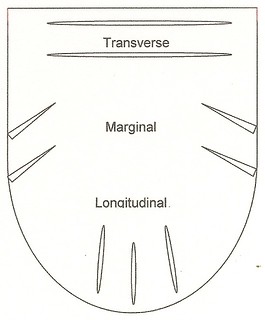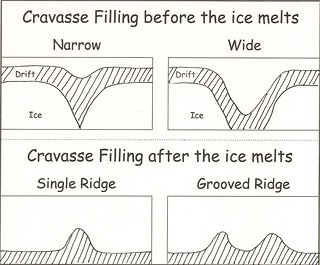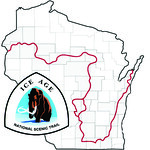The Flambeau Ridge, just a few miles to the north of the Chippewa Moraine area, is quartz bedrock that is about 400 feet higher than the area further to the north. This ridge slowed the advance of the glacier in western Wisconsin.
The glacier ice that advanced beyond the ridge was thin and stagnant for an extended period of time. These conditions are responsible for the terminal moraine that we know today as the Chippewa Moraine. Thin ice also had many crevasses that debris fell into. When the ice melted the debris in the crevasses would leave a ridge called a crevasse filling; (see GC4Q3CF; IATCC - Cracks in the Ice)
A grooved top ridge is a type of crevasse filling. Unlike the typical crevasse filling that has a single, narrow crest, a grooved top ridge has two parallel ridges separated by a trench-like linear depression. They formed in crevasses that were wide enough so that the drift that fell into them did not completely fill the opening. There was more debris by the edges of the ice, than there was near the center. When the ice melted away, ridges were left on both sides of the where the ice was with a trench between them.

 Due to the thin ice, the crevasses (and the ridges left behind), tend to be longitudinal ridges.
Due to the thin ice, the crevasses (and the ridges left behind), tend to be longitudinal ridges.
 IATCC is the cache designation to highlight a series of EarthCaches along the Ice Age National Scenic Trail grouped into a special category called "ColdCache."
IATCC is the cache designation to highlight a series of EarthCaches along the Ice Age National Scenic Trail grouped into a special category called "ColdCache."
The Ice Age Trail is one of eleven National Scenic Trails designated by the National Park Service. This unique trail is entirely within the state of Wisconsin and follows along the terminal moraine of the most recent glacier which retreated about 10,000 years ago.
This project is supported by the Ice Age Trail Alliance (IATA). The goal is to bring more visitors to the trail and promote public awareness, appreciation, and understanding of Wisconsin’s glacial landscape.
The IATA has created an awards program to encourage visits to the trail and ColdCache sites. This awards program is separate from, and in addition to, any other Geo- or EarthCache awards program.
A current list of approved ColdCache sites can be found on the “IATCC Bookmark List”. More information on the Ice Age Trail Atlas, the Companion Guide, the ColdCache Project and Awards Program can be found on the “ColdCache Webpage”
Resources
Geology of the Ice Age National Scenic Trail; by David M. Mickelson, Louis J. Mahler Jr., and Susan L. Simpson
Stagnant Ice Landforms of the Chippewa Moraine; Taylor County, Wisconsin; By Adam Cahow; Open-File Report 1987-08, 24 p.
The Petrography of a Portion of Chippewa and Eau Claire Counties of Wisconsin, by Everett Carlyle Edwards
www.wisconline.com/wisconsin/geoprovinces/northernhighland
DNR Permission
The Geocache Notification Form has been submitted to Mike Rivers of the Wisconsin DNR. Geocaches placed on Wisconsin Department of Natural Resource managed lands require permission by means of a notification form. Please print out a paper copy of the notification form, fill in all required information, then submit it to the land manager. The DNR Notification form and land manager information can be obtained at: www.wi-geocaching.com/hiding
Logging Requirements
1. What is the directional orientation of grooved ridge? Based on this information, what direction did the glacial ice come from at this location?
2. How much space is between the two ridges that the groove is between? Based on this information, how wide was the crevasse when it was being filled with glacial drift?